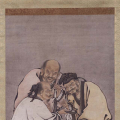Welcome home! Please contact lincoln@icrontic.com if you have any difficulty logging in or using the site. New registrations must be manually approved which may take several days. Can't log in? Try clearing your browser's cookies.
shamata, concentration, and mindfulness
 Jeffrey
Veteran
Jeffrey
Veteran
in Philosophy
How do these terms relate to each other?
0

Comments
You'll get a dozen or more different answers here and no two are likely to be the same. How to know which is right?
Get an answer that is praised by the wise. Ask your teacher.
concentration is focus on one object and building the momentum towards more and more focus leading to the absorption states.
mindfulness is a general focus on various objects. this too builds the momentum of concentration yet that isn't necessarily the emphasis. the emphasis being different dependent upon the intention and view of the individual implementing the practice.
the metaphor of contour drawing verse say drawing in general is what i'd use as the difference and similarity of concentration and mindfulness.
concentration being contour drawing. a specific focus on the outline of an object as you draw it. whereas mindfulness is the general principal of attention on object or objects.
another way to discuss this would be concentration focuses on say the tip of the nose. coming back the that specific spot continually as one gets distracted. this gradually becomes easier and easier and one develops the muscle and discipline.
whereas mindfulness could focus on the whole breathing process. in breath cold nose to neck to chest inflating and stomach jetting outwards to stomach moving towards spin chest and shoulders move downward and breath leaves nose as warm air. then one could even be mindful of the various sensations, thoughts, feelings, visuals, audios, etc. It's a more fluid process and can tend to be more expansive in nature.
mindfulness could also have a specific intention. say you have the intention to learn about impermanence. so you bring the view of impermanence to what you experience. and all experience has the context of impermanence, which leads to more and more letting go, relaxation, etc.
when both fuse into one activity then we have meditation (expansive awareness and focused awareness). kind of like being able to see the whole composition of an artwork and then also see how the different objects are separate and relate to each other.
the point of all this is insight and letting go. so one can start to see how attention builds the arena of perception. linking and unlinking. one can start to tease out the variables/condition that factor into building perception. by seeing how perception is built then one can automatically see how perception is unbuilt.
one needs both focus that is like a laser and can hold an object. and also a focus that is wide and expansive. tight and loose all at once.
@Jeffrey, just wanted to say that Trungpa Rinpoche's book goes into this. ALOT. There is an entire like 150 page section just on Shamata. Excellent book. "The Profound Treasure of the Ocean of Dharma Volume One: The Path of Individual Liberation." It's just too much information for me to attempt to put in my own words. But well worth reading.
His question is a perfect question for a teacher and probably one of the worst to post to a forum.
My teacher and I are apart all the time, but I can still send an email. He has wisely set up a network of senior teachers I can call upon and our resident lama is always available for consultation. For a question like Jeffrey's I'd go to my Practice Instructor first.
You'll probably notice I don't pose many practice or study questions here. There's a reason for that. I have teachers who will give me straight, honest and consistent answers in keeping with our study and practice lineage. Every. Single. Time. These are people who know me and my practice and study history personally. I don't see any point in fielding a dozen different answers when an appropriate answer is a phone call or email away.
I will continue to recommend that people find a similar arrangement. It can be done, even if you live in Flin Flon, Manitoba. The blessings cannot be measured.
My teacher is gone for 6 months at a time in Asia, mostly unreachable by email. There are other teachers who fill in and senior students who can help as well. But he encourages us to discuss and debate with each other as well. Often times, we find we learn the most when we are giving answers to others. So, it is helpful to think of questions the same way. We might learn more in attempting to answer the question ourselves. So I, for one, am glad everyone doesn't take the difficult questions just to their teachers because there are a lot of them I'd never hear. I appreciate questions that make me think about what my answers would be, even though I am not ready to offer them as an answer yet.
Samatha is a form of meditation or mental cultivation that leads to calm and composed as opposed to vipassana(when yoked to samatha) which gives rise to wisdom or insight into reality. The mind that is in samadhi is focussed and composed.
These 3 terms are closely related but not synonymous.
I'm too stoopid to know the difference. I thought concentrate was a form of undiluted drink.
Maybe I need to be more mindful.
Shamatha???
Isn't that where you casually sit around, wondering when it will be time for a nice drink of tea?
Wait that may be 'sham at tea time' . . . oh I dunno
:scratch:
. . . sounds like you iz becoming a 'serious practitioner' @Jeffery. Don't let it effect your innate Doofus Nature (similar to Beginners Mind but more like 'Toddlers Mind') :vimp: